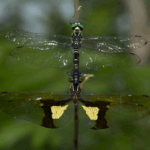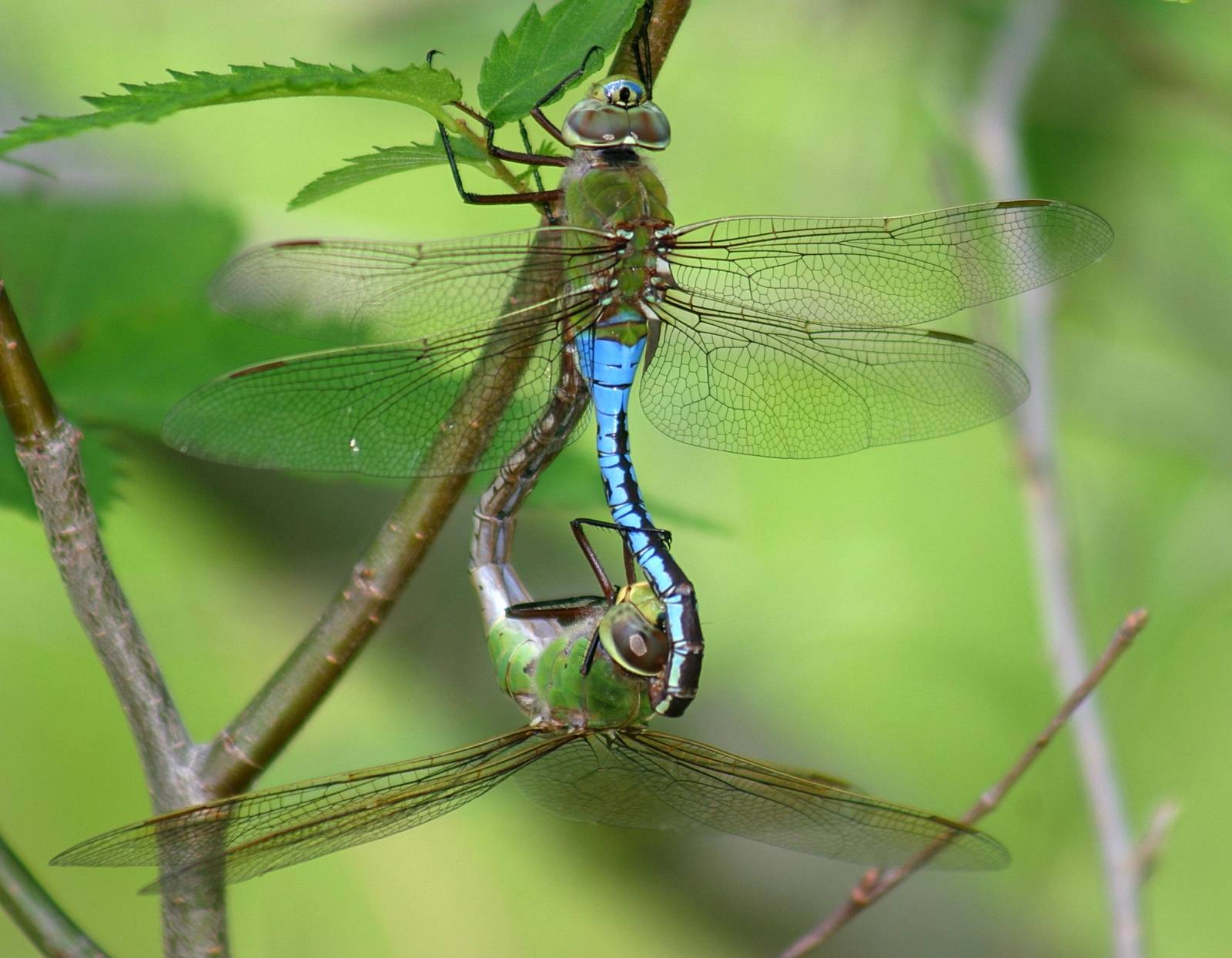
when is dragonfly mating season
Unfortunately, adult dragonflies only live about two months, giving us little time to enjoy their grace and beauty amidst the late summer.
those of you who haven’t noticed it is dragonfly mating season. Each year dragonflies come courting from late July until September while the temperatures are still warm. Dragonflies themselves are rooted deep into American and European folklore as being seen as evil and sinister as well as representing purity and an active lifestyle in Native American cultures. These are all just myths, the truth is the dragonfly is a beneficial insect within our ecosystem because it eats mosquitoes as well as other insects that not only pester us, but also spread illness and disease.
The Dragonfly Mating Game – A Contact Sport
Romance and courting have no place in the dragonfly mating ritual. In fact, it is a bit violent and somewhat unsettling. However, dragonflies must be doing something right, as they have existed for over 300 million years.
When do dragonflies mate?
When dragonflies mate varies between different species and areas. For example, some species will emerge early in the spring and have mated before mid-summer, laying their eggs shortly afterward. Others won’t emerge until later in the summer or have longer on the wing. The majority of dragonflies, however, will mate in the summer, as this is when conditions are best for the adults to have emerged.
Emergence is often on mass, with warm weather or other suitable conditions triggering it. Up to this point the dragonfly larvae will have been living under the water, but they will climb out and burst out of their skin to become an adult.
| Dragonfly Species | Mating Season |
|---|---|
| Common Whitetail | Late spring to early summer |
| Eastern Amberwing | Summer |
| Blue Dasher | Late spring to summer |
| Widow Skimmer | Summer |
| Four-spotted Skimmer | Spring to summer |
FINDING AN APPROPRIATE MATE
Using their extraordinary eyesight, a male dragonfly must identify a female of his own species. In a pond habitat that is home to many dragonfly and damselfly species, this may seem like a daunting task. However, male dragonflies are up to the challenge. They are able to target an appropriate breeding partner by observing the flight style, color, pattern and size of a female dragonfly.
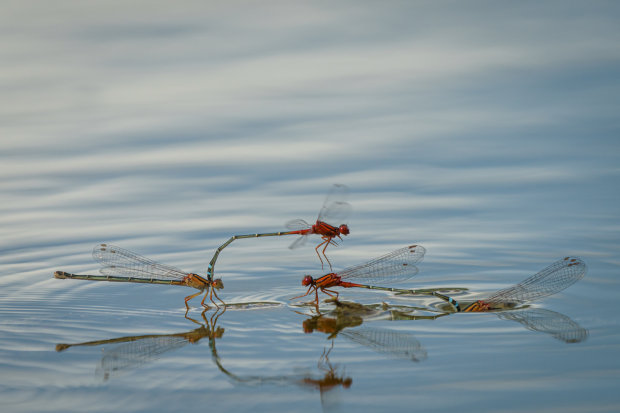
MATING MECHANICS
The first step in the mating process is for the male dragonfly to subdue the female. The typical scenario looks like this. While in flight, the male approaches the female from behind, grabs hold of her thorax with his legs, and sometimes bites her in an effort to quickly subdue her. Pulling his abdomen forward, he uses his anal appendages (cerci) to hold her by the neck while continuing to fly with her in a formation referred to as tandem linkage.
The male dragonfly prepares for sex by transferring his sperm to his penis. Now comes the issue of joining the male’s penis (located at the tip of his abdominal segment) to the female’s genital opening (located near her neck). Once their sex organs are linked, the dragonfly couple forms a closed circle with their bodies.
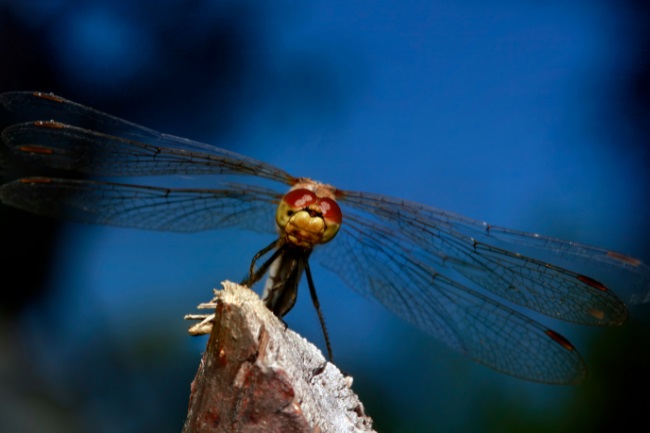
Hold on, there is more. Since a female dragonfly will mate with multiple partners and only the last sexual partner will actually fertilize her eggs, the male dragonfly will scoop out the sperm of pervious mating partners using barbs on their penises. Once he has cleaned house (so to speak), the male dragonfly will position his sperm to maximize fertilization potential. Then he will stand guard and chase away any other males that attempt to mate with his partner.
Table 1: Dragonfly Mating Seasons
After emergence mating generally doesn’t happen straight away. The dragonflies will spend time feeding, exploring and sometimes even migrating. This most likely gives them time to regain their strength and be ready for the exhausting mating process.
How do dragonflies mate?
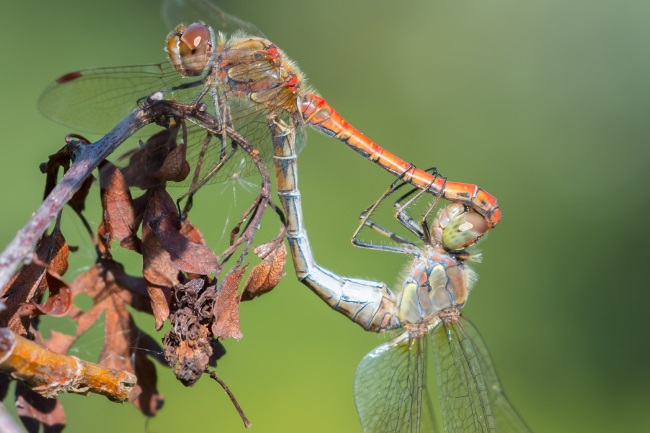
For a dragonfly male, the start of the mating process is usually to find and defend a territory. This is usually a body of water suitable for the female to lay her eggs in. Females will be drawn to this area, meaning he can have his pick. In order to keep his territory, he will spend his time chasing off and fighting rivals, even scaring off other species of dragonflies and insects in his zeal.
Once he’s secured his patch the next thing is to look out for females. In many dragonfly species, the female will be less dramatically coloured, often more camouflaged than the males. She will also be more inclined to keep hidden, as as soon as she emerges she may have a rabble of males chasing her down to mate with her.
Once a male has located a female his first job is literally to grab hold of her. It may seem rather violent to us but he will chase her down, grasping hold of her thorax and even biting her. This chase is important for the male to prove his strength. Only the strongest males are likely to be able to hold a territory and chase down a female. He will then use his cerci (anal appendages which are shaped to perfectly lock in with the back of the female’s neck) to hold her by the neck. This is called tandem linkage.
| Mating Behavior | Description |
|---|---|
| Tandem Flight | The male and female fly together in a tandem position during mating. |
| Mating Wheel | The male grasps the female behind the head with his terminal appendages, forming a “mating wheel” shape. |
| Mating Heart | The male clasps the female with his terminal appendages, forming a “mating heart” shape. |
| Mating Chain | Multiple males may compete for a female, forming a chain-like structure during mating. |
| Mating Guarding | After mating, the male may guard the female from other males to ensure successful egg-laying. |
Table 2: Dragonfly Mating Behaviors
The male then needs to transfer sperm to his penis, as these two important mating tools are confusingly enough is not in the same place. The sperm package is stored near the end of his abdomen, whereas his genitalia is near the top.
The male and female then have some more contorting to do, with the male’s penis, at the top of his abdomen, being joined to the female’s sexual organs, which are found at the end of her abdomen. Seeing dragonflies in this position they can look almost like a heart, looped around each other’s bodies. This is known as the wheel position. Many species will remain joined like this for long periods of time and can be even be seen flying like this.
What happens after they have mated?
After they have mated how they behave depends on the species. Some will remain joined, whereas other species will separate. Often the male remains close by. The female will generally be mated with many times. In order to ensure she father’s his offspring, the male will scrape out his predecessor’s sperm before he inserts his own. To ensure she is safe from other suitors he will therefore often stick around her and scare off other mates until she has laid her eggs.
Dragonflies lay their eggs in a range of places depending on the species. Many lay them directly in the water, while some, like southern hawkers, cut slits into vegetation and lay eggs into these cuts. Adult dragonflies play no role in the lives of their offspring and will leave the eggs to develop into larvae on their own.
Why do dragonflies get stuck together?
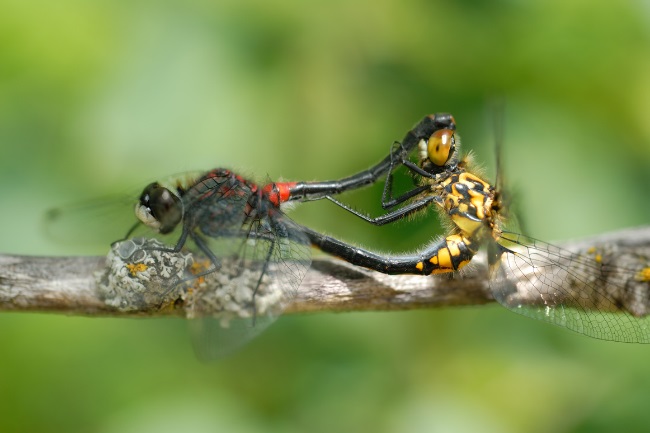
There are a number of ways dragonflies can get attached to each other. Tandem linkage is a one way for them to be joined together. This is where the male is holding onto the back of the female’s neck with his cerci. Amazingly the cerci are the precise shape for the correct species of female. Many males accidentally mistake females from other species for their own and try to grasp hold of them, but like a lock and key, they can only grab their own females.
They usually joined in tandem like this prior to mating but can also return to this position afterward. This has a dual purpose. Firstly, the male can ensure no other males get to mate with his female, and with some species, he will help lower her into the water to lay her eggs. Some males can be overenthusiastic with this dunking though and drown the unfortunate female.
Another common position is the wheel. This is where the male is holding onto the back of the female’s neck with his anal appendage, while the female reaches underneath to allow her genital to connect to his. As mating can last some time they may remain joined like this for several minutes, or even longer.
Do dragonflies mate for life?
Most dragonflies only spend a few weeks as adults and only reproduce at one point in their lives. During the mating process, both males and females may try to mate more than once. While they are not loyal to a particular partner males can be highly defensive of their mate to ensure no other males are able to approach her. This behavior may last until she has laid her eggs and then he will lose interest.
Do dragonflies die when they mate?
Some species of animal will die immediately after mating, the process having so exhausted them they haven’t got the energy to continue. While dragonflies can live beyond the mating act the adults generally don’t survive the winter, and so will not live much longer. Additionally, the mating processes can be very harsh and females can be killed in the process. Males too can die during battles with other males.
Additionally, like many mating animals, the excitement of the mating process can be rather a distraction. In this time, with so many dragonflies in one place, and so many of them not really paying attention, it is the ideal time for predators to grab a mouthful of tasty dragonflies. Exhaustion after the act makes them another easy target. Resting too close to the water for example can give a free lunch to a hungry fish.
The summer of love
There’s something magical about standing in the summer sun and watching dragonflies zoom around you. The delicate loops that the mating dragonflies form can even be fascinating to observe, and many think, romantic. For much of their time as adults dragonflies might not even spend their time by the water, often feeding in fields, along hedgerows, or even in trees. The mating time is when they are most likely to be in large numbers at the water’s edge, so this is a great time to observe and enjoy them.


